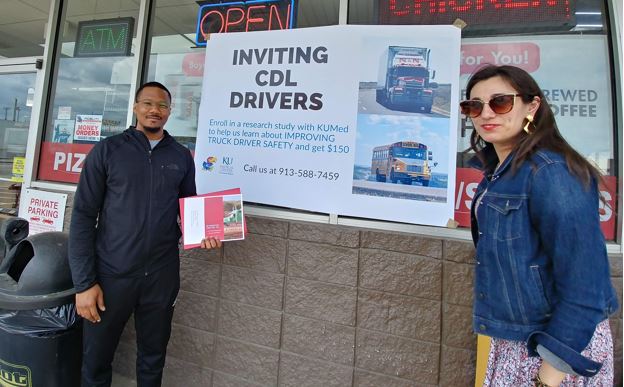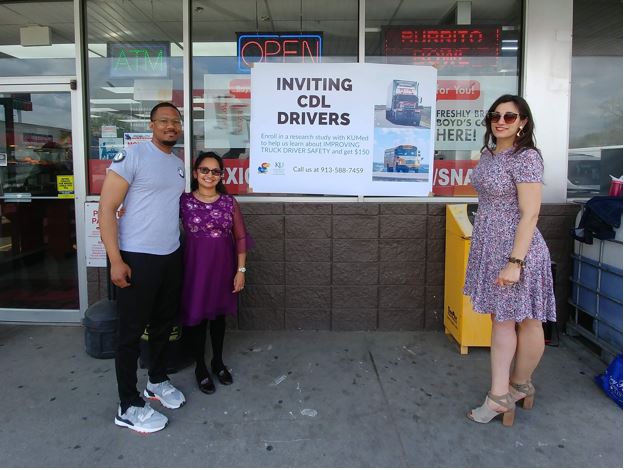
Photo courtesy of Shelley Bhattacharya

Photo courtesy of Shelley Bhattacharya

Photo courtesy of Shelley Bhattacharya
This article was written for the UTC Spotlight Newsletter to be published late 2022. It was written and reviewed by the described project’s principal investigator, co-principle investigators, and students.
Drivers with a Commercial Driver’s License (CDL) carry significant loads, including hazardous freight, and, thereby, have a potential for significant motor vehicle accidents. This is why the U.S. Department of Transportation (DOT) is continually looking for ways to improve highway safety in commercial drivers. The study, Assessing and Improving the Cognitive and Visual Fitness of CDL Drivers at the University of Kansas Medical Center is one project the University Transportation Center (UTC) sponsors. It is currently in its third year of a five-year grant. The ultimate goal of the research is to develop clinical tools to predict the on-the-road driving safety for CDL drivers. This information can then be used by health care providers and the DOT as a framework for commercial truck drivers to improve their driving fitness and, in turn, prevent future accidents.
The study design consists of a battery of motor, cognitive, visual, and driving tests done annually for three years to active CDL drivers. These results are compared to their on-the-road driving performance using a Driver’s Assessment Questionnaire and log data to look for predictive variables for road safety. The cognitive tests consist of the Montreal Cognitive Assessment (MOCA), Stroke Drivers Screening Assessment (the dot cancellation, dot matrices, road-sign recognition tests), Trails A, Trails B and Snellgrove Maze test.
Our team also conducts driving tests via simulation using three driving scenario runs. During the runs, each participant is monitored with a Tobii eye tracking system. The Tobii generates measurable reflection patterns on the eye and processes them through complex algorithms and 3D-modeling. This technology allows the team to evaluate physiologic eye position and point of gaze in real-time with driving simulation performance. The data is then used as a metric to analyze potential associations and risk factors. Additionally, it allows for the testing of innovative instruments that may track inattention and drowsiness.
In addition to cognitive and simulator examinations, there are tests centered on motor function and visual performance. The visual aspect involves a field of vision examination using Useful Field of View and a formal eye examination using the Keystone system, focusing on functions such as depth-perception, night vision, color, and refractive errors.
All of these tests, with the exception of the MOCA, are graded for number of errors and are timed—in addition to other data points when the study design calls for it—and analyzed in relation to driving simulation performance. There are many factors that contribute to commercial driving safety. The study plans to identify these factors, including cognitive aspects, and apply them to a framework for improving safety, health, and wellness of commercial truck drivers. By identifying potential markers, the study will analyze the data in coordination with the driving simulation information and provide a key link to understanding the framework of driving safety. The study is designed to help determine what tests affect fitness-to-drive and how we can maintain safety on the road by improving these skills—be it visual, cognitive, general health, or motor.
After each subject completes their annual assessment, they are given a summary sheet with their respective scores in each domain. This is reviewed with the subject and research team, emphasizing their strengths and providing tools to help them improve any weaknesses. Results are not reported to the Department of Motor Vehicles, the Department of Transportation or their employer.
The research project, Assessing and Improving the Cognitive and Visual Fitness of CDL Drivers, takes place at the University of Kansas Medical Center, in the Laboratory for Advanced Rehabilitation and Research (LARRS). Dr. Shelley Bhattacharya, the Principal Investigator for the study, is a board-certified physician in Family Medicine and holds a Certificate of Added Qualifications in Geriatric Medicine, issued by the American Board of Family Medicine. Dr. Hannes Devos and Dr. Abiodun Akinwuntan are director and co-director of the LARRS lab, respectively. Medical students Rob Gibson, Payton Lancaster, Corrina Lemke, Chris Denton and Chase Branstetter are involved in data collection, recruitment, and day-to-day operations.
Share your News with MATC!
If you are a student, faculty member, or other affiliate of the Mid-America Transportation Center, we are eager to share your news of your work and accomplishments.
Send your information to Madison Schmidt at mschmidt24@unl.edu and it could appear in MATC's website, newsletter, Facebook, and Twitter.